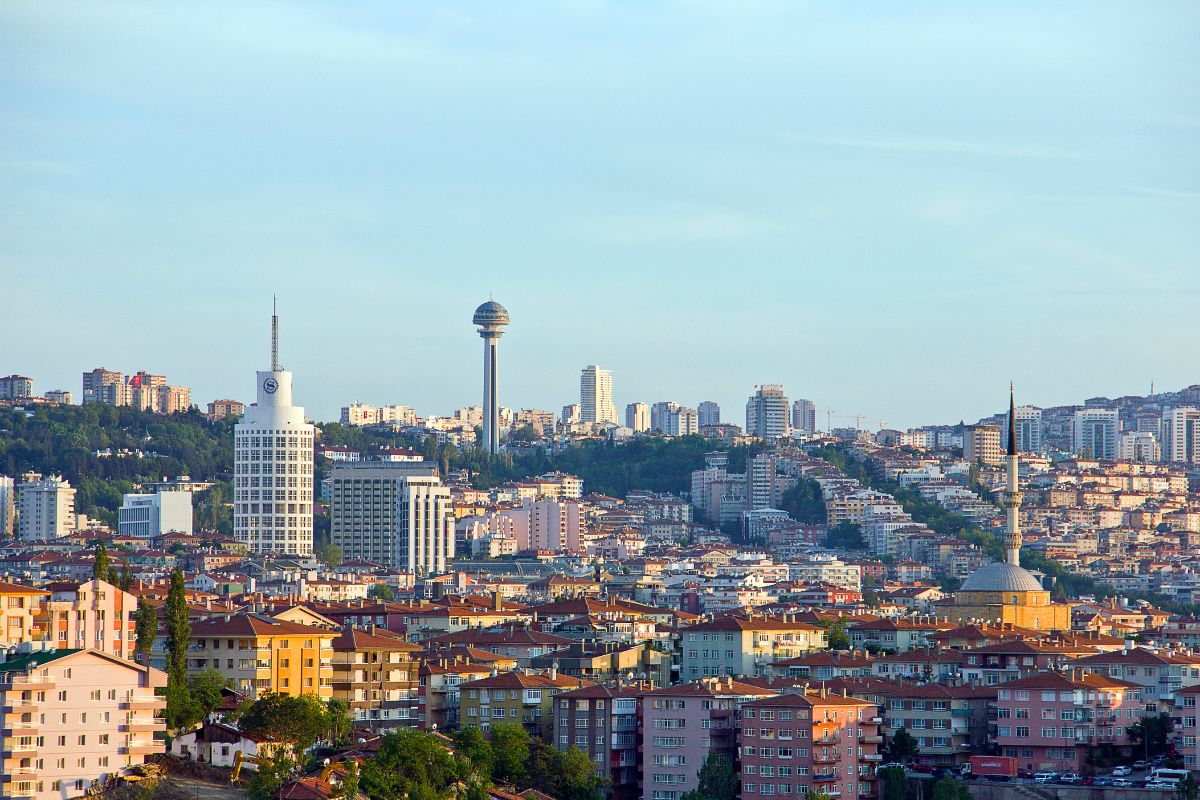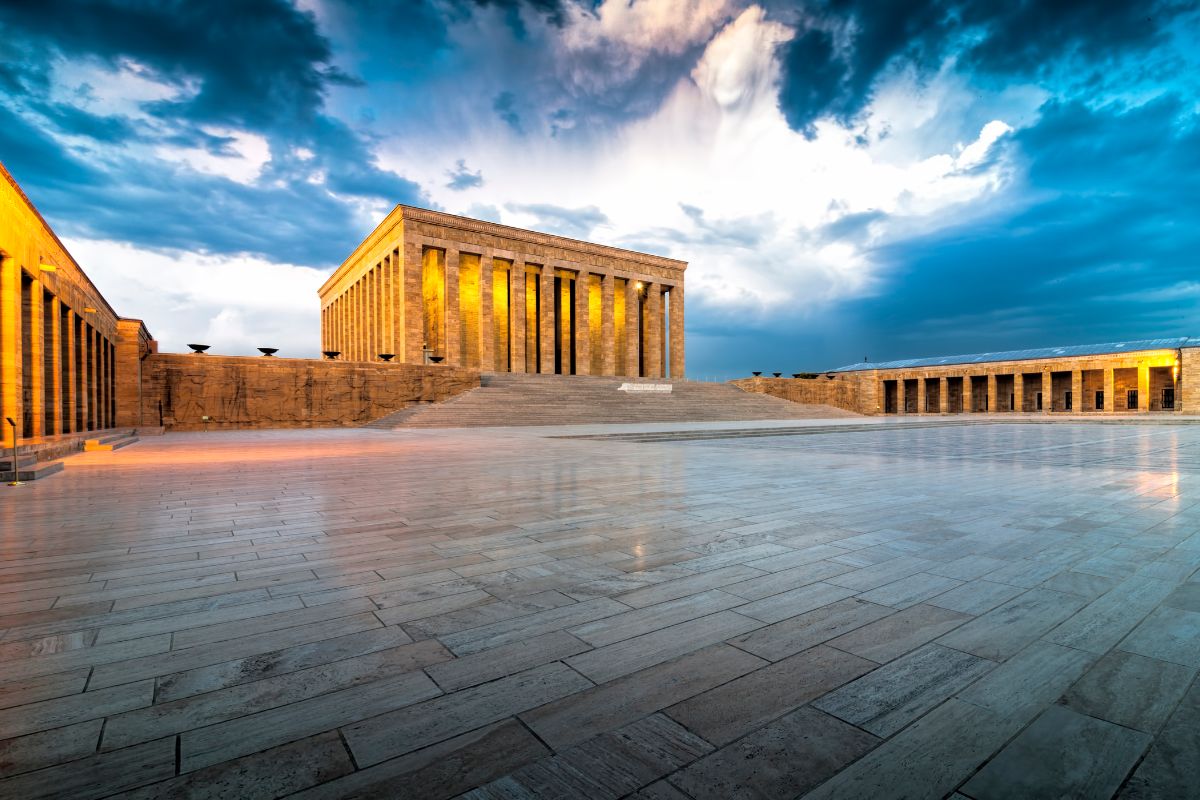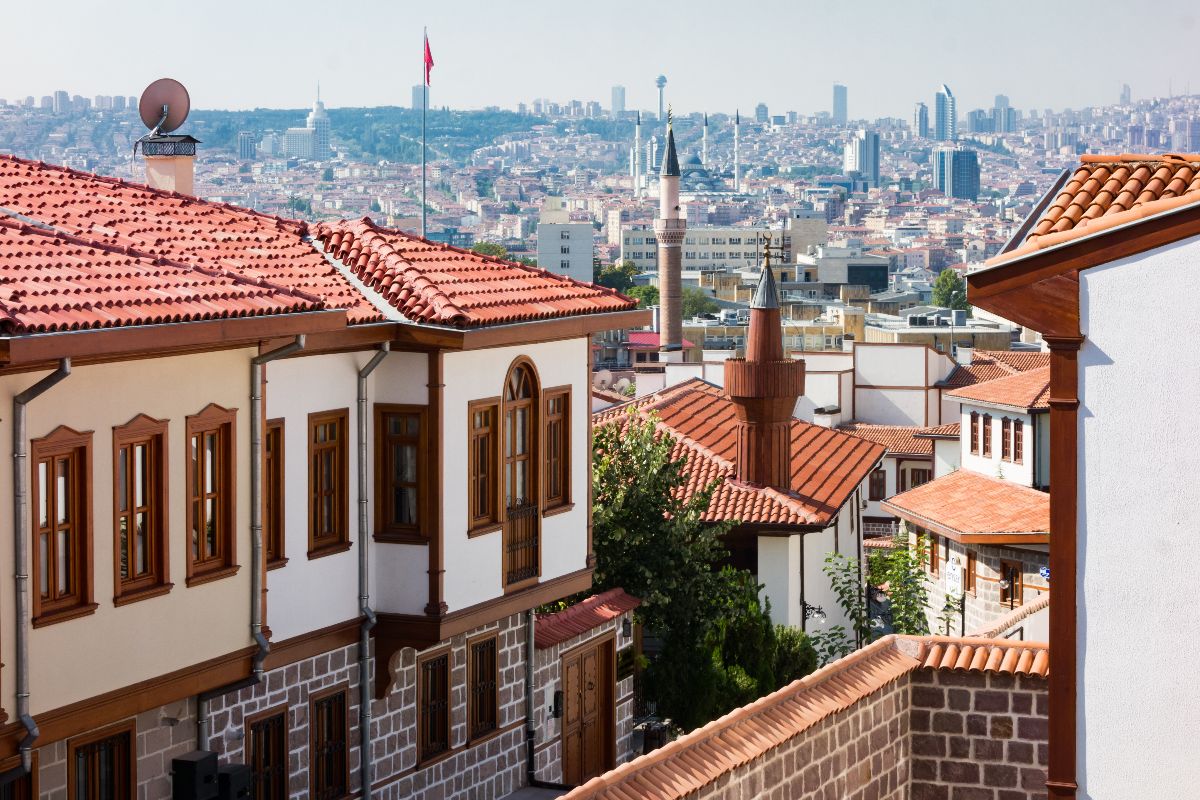Despite being its capital, Ankara does not always appear among the priorities of travelers visiting Turkey.
And this is due to the extraordinary ‘competition’ it has in its own country, but not for lack of attractions.
In fact, for those who come to discover it, this city becomes one of the most attractive places to visit. pleasant surprisefor several reasons: its ancient history its ancient history, its young and dynamic character and even a cosmopolitan point thanks to the numerous embassies and its strength in the business world.
Therefore, on this page we tell you in depth what to see in Ankara, what to do, how to get there and other information of interest for your trip.
Ankara is the capital of Turkey and is at its very heart: in Central Anatoliawithin the province of the same name.
It is because of this, and also because of its decisive character in the times of the fledgling Republic of Atatürk, that this hitherto modest city grew into the megalopolis of today, with a population of nearly 6 million inhabitantsmaking it the second largest city in Turkey, after Istanbul.
This central character within the Anatolian peninsula means that its distances from the main places in the country are similar, which is an interesting geographical fact for any capital city.
This is a list of distances with the main Turkish destinations that can also be part of your circuit:

A fundamental aspect of Ankara is its geographic context: its immediate surrounding territory is a flat plain which is located in the high plateau of central Anatolia (about 800 meters above sea level), but its urban center is located even higher, on a steep hill that reaches approximately 940 meters above sea level.
If we add to this the remoteness from the sea, the mountainous character of the rest of the region and the modest rainfall it receives (concentrated in winter and spring), the result is an extreme climate, with very hot summers (above 30º C). (above 30º) and very cold winters and very cold winters (with negative minimum temperatures and relatively frequent snowfalls).
One of the advantages of Ankara is that, being the capital and the second most populated city in the country, it enjoys a good transport infrastructure and direct connections with the rest of the cities in the country.
Below are the main options to reach the city from other countries and from other Turkish destinations.
Ankara has one major international airport: Ankara Esenboğa Airport (IATA Code: ESB). Ankara Esenboğa (IATA Code: ESB).
Se encuentra a unos 28 km from the city and usually operates the following air routes with airports in other countries:
With regard to domestic flights domestic flights, being the capital of the state, it practically has direct routes with all Turkish airports, thanks to local airlines (Pegasus, AnadoluJet, Turkish Airlines): Adana, Adıyaman, Ağrı, Alanya, Antalya, Balıkesir, Batman, Bodrum, Bursa, Çanakkale, Dalaman, Diyarbakır, Edremit, Elazığ, Erzincan, Erzurum, Gaziantep, Hatay, Istanbul-Sabiha Gökcen, Izmir, Kahramanmaraş, Kars, Malatya, Mardin, Muş,Samsun, Siirt, Şanlıurfa, Tekirdağ, Trebisonda, Van.
The high-speed rail network high-speed is taking its first steps.
And, fortunately it has Ankara as a fundamental core of its (still) modest network.
The reference station is, in this case, Ankara Tren Garıalso referred to as Ankara YHT.
Hasta aquí llegan las siguientes líneas:
In addition, there are numerous long-distance trains which, without being high speed, can be a practical way to reach the city from other points such as Diyarbakir, Izmir, Kars or Tatvan, in addition to the aforementioned Istanbul, Konya or Eskisehir, which also have alternatives to high speed.
Although their routes take longer, many of them are at night, which allows you to take advantage of the night to rest while traveling.
On the other hand, the international train lines are more scarce in Ankara, for geographical reasons, and practically the only train that arrives here from other countries is the Trans Asya Treniwhich brings passengers from Tehranthe capital of neighboring Iran.
The bus is, without a doubt, the most used means of public transport to reach Ankara from other parts of the country.
Its station, the otogar ASTIThe bus station is a huge infrastructure with numerous docks where the flow of buses and passengers is constant.
Practically all cities, even medium-sized and many small ones, have a direct connection to the capital.
And as with the trains, many of these buses run at night.
However, these lines are domesticHowever, these lines are domestic, i.e., they do not come from other countries: given Ankara’s remoteness from the capitals and major cities of neighboring countries, reaching Ankara by bus is not an attractive option for travelers and, therefore, the companies in the sector hardly offer them.
Ankara’s good road connections make it easy to get here by car as part of a larger tour of the country.
For example, it is halfway between Istanbul and Cappadocia (Kayseri).
No obstante, los trayectos son relativamente largos con el resto de grandes destinos turcos, por lo que no se puede concebir la visita a Ankara como una excursión desde dichos destinos.
This is a list of the approximate approximate driving times driving time from other cities:
Although Ankara, until the 20th century, did not play a major role in world history, it is a city with very ancient roots. very ancient roots and preserves some vestiges that will delight travelers interested in past cultures.
What is now Ankara was once under the rule of the HittitesThe first great empire of Anatolia (with its capital at Hattusa, about 200 km to the east), during the Bronze Age.
There is evidence that this was already the case in 1200 B.C., when that civilization called the city Ankuwash.
However, it was with the Phrygians that this settlement really prospered from the 10th century BC onwards and, in fact, it is attributed to King Midas is credited with the mythical founding of the city, under the name of Ancyra.
Su principal interés radicaba en su estratégica posición en las rutas comerciales terrestres entre Europa y Asia.
In the following centuries it was subject to various conquests and control by Lydians, Persians and even Macedonians. Lydians, Persians and even Macedonians.with Alexander the Great at the head of his troops.
In fact, in Gordius or Gordion (capital of ancient Phrygia, about 100 km south of here) is where the famous Macedonian emperor broke the mythical Gordian knot.
His successors, the Seleucidsmaintained control of the city, which later passed into the hands of the Galatians. Galatians (3rd century B.C.), a Celtic people established in Anatolia.
But the power that ended up having the most weight in Ankara was the power of RomeRome, being conquered by none other than Caesar Augustus in the year 25 B.C. Its name, by then, became Ankyrabeing the object of different construction projects, both religious and civil.
Their successors Byzantines maintained their dominion over the city, not without difficulties at certain times, especially to defend themselves from Persian and Arab attacks, which did not bear fruit.
They did succeed in the conquest of the SeljuksThe first Turkic empire also had to defend itself tooth and nail against its enemies.
The same thing happened with the successor power, the Ottoman Empirewhich in its first century of existence suffered the harassment of the Turkmen TurcomongolsThe Ottoman Sultan defeated the Ottoman Sultan Bayezid I at the Battle of Angora (the name of the city at that time) in 1402, taking him prisoner here.
However, the city returned to Ottoman hands shortly thereafter and has never since occupied a preeminent place in the Ottoman Empire.
Far from the great ports and strategic natural resources, it became a city focused on livestock, especially goats.
And so, without any major shocks or remarkable events, Ankara entered the 20th century with a population of barely 20,000, according to some sources.
But everything changed at the hand of Mustafa Kemala, better known as AtatürkThe ‘father of the Turks’: here he established his headquarters during the War of Independence against Greece and its allies, who dominated the east of the country after World War I and the Treaty of Sevres.
And after the victory in that contest, Atatürk decided that it would be the capital of the new nationalist republic. capital of the new nationalist republicThis led to an enormous development and growth in the following decades thanks to the establishment here of the main political and economic powers, to the detriment of Istanbul.
And that is why here is the Anit Kabir, mausoleum of Atatürk, who is not only the father of the Turkish homeland, but also the great architect of modern Ankara.

Ankara’s main sights are related to its history, both ancient and recent, as well as buildings that look to the future by embracing avant-garde architecture of aluminum, glass and other contemporary materials.
If one had to choose an iconic monument and place for Ankara, it would be the Anit KabirAnit Kabir: this is the monumental mausoleum erected for the glory of Mustafa Kemal Atatürk.died in 1938.
Its architecture is a mass of marble where sobriety and symmetry prevail, in a clear turn of the screw to the classical temples that are scattered elsewhere in the country.
And all this is highlighted by the symbolic place chosen for its construction: the top of one of the most prominent hills of the city.
The Anit Kabir houses museums, cultural spaces as a library, an imposing courtyard of the Lions as a nod to the power of the ancient Hittite empire and, of course, the tomb of Atatürk, whose wealth has nothing to envy to the mausoleums of the Ottoman sultans.
The mentioned museum of the Anit Kabir is a biographical space on the life and work of Atatürk, interesting to learn more about the figure of the ‘founder’ of modern Turkey.
But if we talk about museums, there are others in the city that have a greater interest if possible, for the value of the collections they treasure and expose.
The most important is perhaps the Museum of Anatolian Civilizations.
Se trata de un espacio de visita imprescindible para descubrir la riqueza y complejidad del pasado turco, especialmente en la península de Anatolia, una auténtico crisol de culturas que se sucedieron siglos atrás y que lograron contribuciones decisivas para el progreso de la civilización.
For example, it is the reference museum to learn more about Çatalhöyük, considered by some authors as the first city in the world.
Of course, a fundamental space is the one dedicated to the Hittites, a great Anatolian empire that rivaled Ancient Egypt, with cuneiform tablets of great value.
And there is no lack of rooms and pieces from other periods, from the Neolithic to the Roman domination, with special mention of Assyrians, Phrygians and Urartians, among others.
Another archaeological museum of interest is the ErimtanThe Erimtan, of private initiative: the businessman and philanthropist Yuksel Erimtan, who put together the collection that is exhibited here, with Roman, Hittite, Byzantine, Bronze Age objects… and much more, with interactive resources for its proper interpretation.
Completing the museum panorama are the Museum of Painting and Sculpturewith Turkish artists of the XX century and works that combine the figurative and the abstract, the Ethnographic Museum with works in wood, ceramics and jewelry, and also the Vakif Eserleri Muzesia must for those interested in Turkish fabrics and carpets.
In terms of historical buildings, the most important are the Citadel or castlelocated on a promontory from which the whole city is dominated.
It was erected by the Byzantine emperor Manuel II in the ninth century, over a previous fortification.
In recent years, both its walls and its surroundings have undergone a process of rehabilitation that has given it back a certain splendor.
As far as religious temples are concerned, the Arslanhane Cami mosque Arslanhane Cami Mosque is probably the most iconic, for its history and beauty.
It dates from the Seljuk period (13th century) and perhaps that is why it lacks the famous Ottoman minarets, omnipresent in the country.
In this case, it has only one and a factory of brick and ashlars of the most ancient.
Its interior, with a wooden ceiling, is one of the masterpieces of that period.
Very different (and very venerated) is the Haci Bayram CamiThe Haci Bayram Cami, from the 15th century with Ottoman minaret and 17th century tile decoration.
This list of places of historical-artistic interest would be incomplete if we did not mention the Roman remains. Roman vestiges that, although scarce, are still preserved in the city.
Highlights in this regard the temple of Augustus and Rome, the Roman baths, the Julian Column or even a battered Roman theater.
And for those who want to stroll through the center to soak up the atmosphere and the most genuine character of the city, you can go to the Kizilay Squareconsidered by many the nerve center of the city.
The Atatürk Boulevard (or Bulvari), also called protocol promenade for being the place of the great celebrations of the state, is another artery of great symbolism and monumentality, with rationalist and modern buildings that exemplify the development of the city in the twentieth century.

If you would like to learn more about Ankara on your own, you can go to the tourist office located in the Citadelwhere leaflets, maps and other materials for discovering the city are available.
At other points in the city, such as its bus stations, there are information booths, although they are not usually staffed.
Ankara has different means of transportation to move around the city.
It has one of the few Metro systems in the country and, although it has only three lines, it can be useful for travel to the central bus station and other points in the center.
The main station, which serves as the epicenter of the network, is Kizilay, in the neighborhood of the same name.
The city bus network (dolmus) is much more extensive, branching out to practically the entire city: both long-distance train and bus stations and major arteries of the city, including Atatürk Bulvari.
Finally, the transfers to and from the airport can be made by bus (Belko Air), which connects this infrastructure with the main train and bus stations, as well as with Kizilay Square.
Departure frequencies range from 30 minutes to one hour, depending on the day of the week and time of day.








